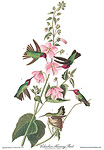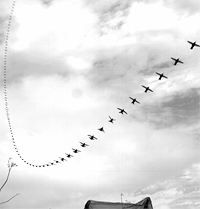| |
 |
| |
Anna's Hummingbird (Calypte anna) |
| |
|
| |
Narrative and Science Lens
|
| |
 |
 Image courtesy of Christopher James Clark Image courtesy of Christopher James Clark |
Audubon shows four males and a nesting female. Note the fanned tail of the upper left male and consider the idea that the two outer feathers are capable of producing a loud chirping sound.
Here's how it works: In its 12-second aerial display, the male climbs 100', takes a J-shaped dive, swooping down and then, while curving upward to form the bottom of the "J", fans its tail for 60 milliseconds, as seen in the photo. At that point, a 50-mph air stream forces the inner vanes of the two outer tail feathers to vibrate like the reed of a woodwind instrument, and the bird quickly “plays” a very loud, “chirp.” For more, see Science, below. |
| |
Note that sexual selection could be at work if females prefer males who produce this tail-derived sound and if it has led to the evolution of sound-producing tail feather shapes. Interestingly, though, males also perform these displays to male Anna’s Hummingbirds and to a variety of other birds (including sparrows, towhees, and various other non-nectarivores) that do not compete with the hummingbirds for food or nesting sites. These pugilistic hummingbirds seem fearless, and are often seen chasing much larger birds, including hawks and ravens. |
| |
|
| |
 Campus Locations Campus Locations
Abundant throughout campus, nesting in virtually any type of tree or tall shrub, even in areas with heavy human activity. Nesting occurs primarily from late January through summer, peaking in spring. Concentrations may be present at flowering trees, such as eucalyptus.
|
| |
Campus sustainability |
| |
This species has likely benefited from non-native flowering plants, expanding its range northward and into cooler climates. Although it is abundant on campus, planning for periods of extreme weather could reduce potential losses. For example, providing both drought-resistant late-blooming and early blooming species with trumpet or tubular shaped pink, red, purple, or orange single flowers and avoiding dead-heading to allow the birds access to remnants of pollen or nectar from old blossoms, if fresh blooms are unavailable, may help. |
| |
What you can do |
|
1. Become familiar with these birds and flowers they prefer and report seasonal lapses in blossom availability. |
|
|
| |
Science
|
| |
Experimental evidence of tail feather chirping: Christopher Clark and Teresa Feo
pinpointed the timing of the chirping sound and removed or trimmed the outer pair of tail feathers (which regrow) and found that the dives of "trimmed" birds were chirpless. Their work included experiments performed in a high-speed wind tunnel at Hopkins Marine Research Station. For more, see the Proc. R. Soc. B report.
|
| |
Essays from The Birder’s Handbook: |
| |
Nonvocal Sounds; Hummingbirds, Nectar, and Water; Hovering Flight; Hummingbird Foraging Bouts; Coevolution;
Optimally Foraging Hummers; Range Expansion; Bathing and Dusting; Feeding Birds
|
| |
References:
Ewald and Orians, 1983; Powers, 1987; Stiles, 1972, 1982; Clark and Feo, 2008.
|
| |
Videos:
Stanford mechanical engineering professor David Lentink and his students have been capturing slow-motion video with an eye toward building wing-flapping robots. See
Stanford Students capture the flight of birds on very high-speed video. Lentink has been making his camera and students available to local birders. Lentink says: “We'd like to pair the camera with some bird enthusiasts who might know the natural history of these birds better than us.” He continues, “We want to give people outside of Stanford the magical experience of using this camera and hopefully learn something more about birds in the process.” (See this questionnaire and/or email questions to birderquestionnaire@gmail.com).
|
| |
Art |
| |
Photos: |
| |
Johanna van de Woestijne's photo of an Immature Anna’s Hummingbird shows perching rather than hovering while feeding in rurban native plantings near campus. This female Anna’s Hummingbird is gathering webs to use as nesting material--Palo Alto Baylands, CA. This Anna's Hummingbird foraging on Agapanthus shows the potential role of these birds as pollinators. See more of Johanna's photographs.
|
| |
Drawings and Paintings: |
| |
DW drawing after Audubon |
| |
|
| |
To add to the Science or Art links, submit bird sightings, comment on the exhibit or the web presentation, or ask questions, please use the web forms on the Art at Exits home page.
|



 Image courtesy of Christopher James Clark
Image courtesy of Christopher James Clark